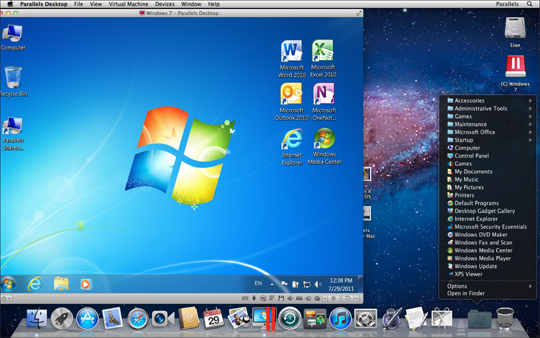Alternative Methods for Running Windows on Your Mac
You may be happy to know there is another way to install and run Windows (and other operating systems) on your Mac that doesn’t require partitioning a section of the hard drive. My biggest beef with the Boot Camp method is that the partition you create for Windows has a fixed size — it doesn’t increase or decrease, which can waste a lot of space if you don’t use all of the partition. On the other hand, it may not be large enough to contain all of your data. My second beef is that I’m limited to installing Windows and not alternative operating systems like Linux. Thankfully for folks like me, there is another way: virtualization.
Virtualization is a method that allows you to install multiple Intel-capable operating systems on your Mac at the same time (as many as your hard or external drive can hold) and run them simultaneously within OS X. There are several software packages out there that can help you achieve this dream, some of which I mention here. These applications help you create virtual machines on which you can install operating systems. These virtual machines access the computer hardware and run at almost native speeds. Another great upside to virtual machines is that they can be made to expand or contract based on the amount of data they contain, which prevents you from wasting hard drive space.

I do not endorse any one of the upcoming software titles over another. All three have their pros and cons, and one may suit me better than it suits you. The two titles that you have to buy offer free trials you can download. The third option is free, so there’s no reason not to give each one a go and determine which you like best.
Parallels Desktop for Mac
Parallels Desktop for Mac from Parallels was the first viable virtualization option for Macs with Intel processors. The latest release (as of this writing), version 7, introduced many new and powerful features, such as improved battery life for laptops, up to 1GB of video memory, faster start-up and shutdown for Windows, improved data security, better compatibility for Linux systems, enhanced 3-D performance, and support for Surround Sound 7.1. All of this allows you to simultaneously run multiple virtual machines even more efficiently than before, as shown in Figure 15.7.

15.7 Parallels Desktop for Mac in action.
For more information or to download a trial copy of Parallels Desktop for Mac, visit www.parallels.com/products/desktop.
VMWare Fusion
VMWare Fusion, shown in Figure 15.8, is the brainchild of VMWare, one of the most trusted virtualization applications in the PC and Linux markets for years. In 2007, VMWare decided it was time to apply its knowledge of virtualization to the Mac platform and a wonderful competition (from the consumer’s standpoint) began with Parallels. This resulted in both companies trying to outdo each other by making great leaps in software capabilities. This competition caused VMWare to gain a significant chunk of ground technology-wise between versions 1 and 2, and to go even further with versions 3 and 4 (the latest version as of this writing).
Features such as Unity View (the ability to run Windows programs as if they were native Mac applications) and Data Sharing (you can drag and drop files between operating system windows) make VMWare a viable option for anyone who needs to run multiple operating systems on her Mac. To learn more about VMWare Fusion or to download a trial copy, visit http://vmware.com/products/fusion.

15.8 VMWare Fusion booting Windows 7 within OS X.
VirtualBox
If you want to use Parallels Desktop for Mac or VMWare Fusion, you have to shell out some cash. Don’t have any to spare? Don’t worry; you’re not completely without options. As a matter of fact, Oracle has provided you with a very nice option that not only supports multiple operating systems but is also free: VirtualBox, shown in Figure 15.9. VirtualBox doesn’t have all the bells and whistles that accompany the previously mentioned apps, but if you simply need the ability to run Windows, Linux, or another Intel-based operating system within OS X, VirtualBox can get the job done. Check it out at http://www.virtualbox.org.

15.9 VirtualBox running Windows 7 within OS X.
